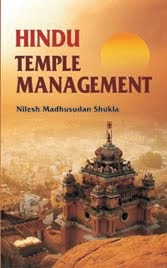Reader would find following topics and more in the book "Hindu Temple Management"
Preface (v)
1. Introduction 1
Objectives 2
Difference between Temple Management and Business Management 4
Temple Management and Managing a Property 5
2. Temples
Architecture 9
Ancient Codes of Temple Creation 11
Antiquity of Temples 12
Temple Structure 14
Structural Parts of Temples 16
Other Parts of Temple 23
Styles of Temple Architecture 30
Temple Design and Vastu-Shastra (Architecture) 36
Function of Temples 37
3. Temple
Functions and Activities 41
Administration 42
Vision Document 43
Setting up Long Term Objectives 45
Making Annual Plans 45
Human Resource Recruitment and Training 52
Code of Conduct for Temple Officials and
Trustees 56
Knowledge Upgrade, Sanskrutik Way 62
Priests and Priesthood 63
New Generation Priests and Temple
Managers 65
Purchase, Sales and Inventory 67
Book-Keeping 68
Stationery, Web-Site and other Tools of
Communication 69
Computer Software, Accounting Packages, ERP Solutions and ISO 71
Membership of Other Hindu Organizations 74
Vigilance 74
Political Scenario 78
Security and Safety 80
What is the Best use of Extra Funds Generated by
Temples? 87
Technology 88
Environmental Considerations 89
Signboards 90
Media and PR and Feedback from Community 91
Interfaith Protocols 93
Curtsies Hindus and Hindu Temples Should Extend to
Christians 93
Curtsies Hindus and Hindu Temples Should Extend to
Muslims 94
4. Maintenance
and Temple Upkeep 97
House Keeping or Cleanliness Management 97
Electro-Mechanical Maintenance 100
Architectural/Civil Contractor Maintenance 101
Community and Temple both Engaging Each Other 101
Temple-Community Engagement Demonstrated by the City of Kaashi 105
Temple Engages Community 107
Interfaith Dialogues and Meetings 112
Tolerate or Respect? Other Religions 113
Community Engages Temple 114
5. Managing
Puja Rituals 117
Benchmark Ideal Puja Ritual and Ways of
Managing 118
6. Laws
and Bylaws of the State 127
Conclusion 131
Endnotes
as Q and A 133
Bibliography 149
Index 155






